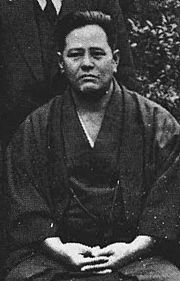Chōjun Miyagi facts for kids
Quick facts for kids Chōjun Miyagi宮城 長順 |
|
|---|---|
 |
|
| Born | April 25, 1888 Naha, Okinawa, Empire of Japan |
| Died | October 8, 1953 (aged 65) Okinawa, USCAR |
| Style | Gōjū-ryū Karate (founder) Okinawan martial arts (Naha-te), Fujian White Crane (Crying Crane style), Southern Buddhist Kung Fu |
| Teacher(s) | Kanryo Higaonna |
| Rank | Sōke, Founder of Goju-ryu, Kyoshi - Dai Nippon Butokukai |
| Notable students | Teruo Chinen, Gogen Yamaguchi, Seiko Higa, Seikichi Toguchi, Tatsuo Shimabuku, Ei'ichi Miyazato, Meitoku Yagi, Seigo Tada, Anichi Miyagi |
Chōjun Miyagi (born April 25, 1888 – died October 8, 1953) was an amazing Okinawan martial artist. He created the Gōjū-ryū style of karate. This style mixes traditional Okinawan fighting techniques with Chinese martial arts.
Contents
Life of a Karate Master
Early Training and Dedication
Chōjun Miyagi was born in Naha, Okinawa, on April 25, 1888. His family was quite wealthy. When he was just 11 years old, Miyagi started learning Okinawan martial arts from Ryuko Aragaki.
At age 14, Aragaki introduced Miyagi to Kanryo Higashionna. Higashionna became Miyagi's main teacher. Miyagi trained very hard and for a long time under Higashionna. This intense training lasted for 15 years, until Higashionna passed away in 1916. During this time, Miyagi also served in the military for two years, from 1910 to 1912.
Learning in China
In May 1915, before his teacher Higashionna died, Miyagi traveled to Fujian Province in China. He visited the grave of Higashionna's teacher, Ryū Ryū Ko. On this first trip, he traveled with Eisho Nakamoto.
After Higashionna's death in October 1915, Miyagi made a second trip to Fuzhou, China, with Gokenki. During this trip, he learned about some local Chinese martial arts. He saw the Rokkishu, which are hand exercises that focus on rotating the forearms and wrists for offense and defense. Miyagi later used these ideas to create his own kata called Tensho.
By combining these Chinese systems with his native Naha-Te style, a new karate system began to form. However, it wasn't until 1929 that Chōjun Miyagi officially named his system Gōjū-ryū. This name means "hard soft style," describing the mix of strong and gentle movements in his karate.
Bringing Karate to More People
After his time in China, Chōjun Miyagi returned to Naha and opened his own dojo (training hall). He taught karate for many years and became very famous as a karate master.
Miyagi's biggest achievements were making karate more popular and organizing how it was taught. His style, Goju-Ryu, was the first karate style to be officially recognized in Japan by the Dai Nippon Butokukai, a respected martial arts organization. He also helped introduce karate into police training, high schools, and other parts of society in Okinawa.
He improved and developed the Sanchin kata, which represents the "hard" side of Goju-ryu. He also created the Tensho kata, which shows the "soft" side. These two kata are thought to hold the main ideas of the Goju-ryu style.
Miyagi also created two new kata called Gekisai Dai Ichi and Gekisai Dai Ni in 1940. He made these to help students learn more complex moves and to connect simpler forms like Sanchin with more advanced ones like Saifa.
His Final Years
Chōjun Miyagi had his first heart attack in 1951. He sadly passed away in Okinawa on October 8, 1953, after a second heart attack.
Who Carried On His Legacy?
Miyagi never officially named someone to take over his school after him. Because of this, several of his students later said they were his successors.
One of his students, Seikichi Toguchi, explained that Miyagi never publicly chose a successor. He believed that if Miyagi had wanted to name someone, it would have been a well-known, long-time student, and it would have been announced publicly.
After Miyagi's death, his most experienced students were Sekō Higa, Meitoku Yagi, Eiichi Miyazato, Koshin Iha, and Seikichi Toguchi.
Miyagi's family later said that he wanted Eiichi Miyazato to be his successor. In February 1954, a committee of Miyagi's main students voted, and almost all of them chose Eiichi Miyazato as the official successor. Miyazato continued teaching at Miyagi’s Garden Dojo and later built the Jundokan dojo with help from Miyagi's family.
In 1963, Miyagi's family also recognized Meitoku Yagi as one of his successors. They gave him one of Miyagi's karate gis (uniforms) and belts.
Other students, like An’ichi Miyagi and Gōgen Yamaguchi, also claimed to be Miyagi's successors later on.
Miyagi's Lasting Impact
Chōjun Miyagi had many important students who went on to spread Goju-ryu karate around the world. Some of his well-known students include Seko Higa, Miyazato Ei'ichi (who founded the Jundokan dojo), Meitoku Yagi (who founded the Meibukan dojo), and Seikichi Toguchi (who founded Shorei-kan Goju-ryu). In Japan, Gōgen Yamaguchi founded the Gōjū Kai organization.
You might have heard of Mr. Miyagi from Karate Kid movies! The character of Mr. Miyagi was inspired by Chōjun Miyagi. The writer of the films, Robert Mark Kamen, was a student of Goju-ryu karate.
Writings by Chōjun Miyagi
Miyagi wrote several important essays about karate. These writings help us understand his thoughts and teachings.
- Miyagi, Chojun. "Karate-Do Gaisetsu. Outline of Karate-Do". March 23, 1934.
- Miyagi, Chojun. "Historical Outline of Karate-Do, Martial Arts Of Ryukyu". January 28, 1936.
- Miyagi Chojun et al. "The Meeting of Okinawan Karate Masters" Fragment of the 1936 meeting records.
- Miyagi Chojun. "Breathing In and Breathing Out in accordance with Go and Ju, a Miscellaneous Essay on Karate". August 15, 1942.
See also
 In Spanish: Chōjun Miyagi para niños
In Spanish: Chōjun Miyagi para niños

